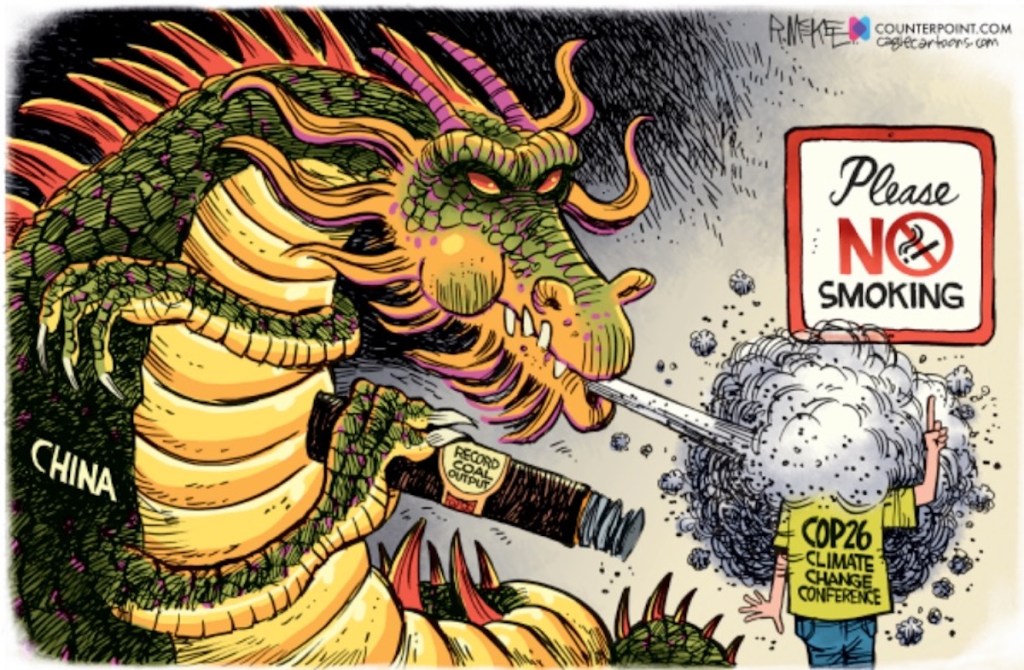It’s not just Senator Joe Manchin (D-WVA) who doesn’t want to let go of coal. It’s China, India, and the representatives at COP26. As I said in “The Failure at COP26,” coal is the dirtiest and most destructive emitter of greenhouse gases. Yet, at the conclusion of COP26, the environmental diplomats in charge of saving our planet from a coming environmental disaster downgraded their statement from “phase-out coal” to “phase-down coal.”
Climate scientists are clear that continued coal emissions will ensure that our climate’s temperature goes over the 1.5°C “tipping point” by mid-century. This will result in the more severe environmental disasters that they have warned about for decades. There is an instructive backstory on the failure to “phase-out coal” which must be understood. “Phasing-down” coal is not just about the fossil fuel industry and nations like China and India wanting to continue burning it; it’s about the inability of nations to effectively address global warming.
At the beginning of COP26, negotiators were pushing for a faster phase-out of coal and fossil fuel subsidies. As the talks progressed, this changed to ending “unabated” coal burning and “inefficient” subsid,es. A third draft wanted to accelerate efforts toward phasing-out coal. The end result was downgrading to phase-down; a cop out. What is even more alarming is that the Paris Accords, in 2015, which identified the 1.5°C tipping point never mentioned fossil fuels, the predominant cause of climate change. COP26 six years later, was the first time a UN climate summit named fossil fuels as the primary cause of climate change.
This is not denial. The negotiators in 2015 knew better. It is political obfuscating and “wordsmithing” in an attempt to present a “positive” outcome to the world. It didn’t work. “Phasing down-coal” was a compromise for the sake of maintaining national economic status and dominance at the expense of the Earth’s environment.
I believe that COP26 was the last best chance for the world’s nations to address an existential climate threat, which failed. As I said in “The Failure at COP26,” it’s now up to local environmental groups, around the world, to pick up the ball and begin to “think globally” while “acting locally.” This can include pushing city, county, and state governments to not only officially name coal and fossil fuels as the major causes of climate change, but to work to have those governments enact state and local laws that stop their burning.
Obviously, this local approach would also include advocating for electric vehicles (EV) and EV charging stations; solar and wind energy development; building codes that promote renewable energy use; stopping deforestation, along with natural resource management preventing climate change destruction. It should also include engaging in media, social and mainstream, to ensure the spread of this kind of 21st-century grass-roots movement around the planet.
It’s sad, profoundly so, that even in the face of the kind of climate caused devastating storms, fires, sea level rise, ecosystem destruction, and human displacement the world experienced between 2015 and now that world leaders ignored science. Rather, they bowed to politics by endorsing a status quo which will inevitably lead to temperatures rising beyond 1.5°C of warming by the middle of the 21st century.
It would be wonderful if around the world, local environmental communities added global advocacy to their work as the antidote to the COP26 failure. At the least, this would slow the climate destruction we are now experiencing. At best, it would start a global movement that could avoid our planet going over the coming climate “tipping point.”

